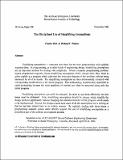The Disciplined Use of Simplifying Assumptions
Author(s)
Rich, Charles; Waters, Richard C.
DownloadMain article (608.6Kb)
Metadata
Show full item recordAbstract
Simplifying assumptions — everyone uses them but no one's programming tool explicitly supports them. In programming, as in other kinds of engineering design, simplifying assumptions are an important method for dealing with complexity. Given a complex programming problem, expert programmers typically choose simplifying assumptions which, though false, allow them to arrive rapidly at a program which addresses the important features of the problem without being distracted by all of its details. The simplifying assumptions are then incrementally retracted with corresponding modifications to the initial program. This methodology is particularly applicable to rapid prototyping because the main questions of interest can often be answered using only the initial program.
Simplifying assumptions can easily be misused. In order to use them effectively two key issues must be addressed. First, simplifying assumptions should be chosen which simplify the design problems significantly without changing the essential character of the program which needs to be implemented. Second, the designer must keep track of all the assumptions he is making so that he can later retract them in an orderly manner. By explicitly dealing with these issues, a programming assistant system could directly support the use of simplifying assumptions as a disciplined part of the software development process.
Description
Submitted to the ACM SIGSOFT Second Software Engineering Symposium: Workshop on Rapid Prototyping. Columbia, Maryland, April 19-21, 1982.
Date issued
1981-12Publisher
MIT Artificial Intelligence Laboratory
Series/Report no.
MIT Artificial Intelligence Laboratory Working Papers, WP-220